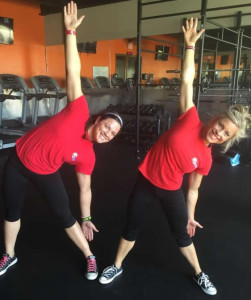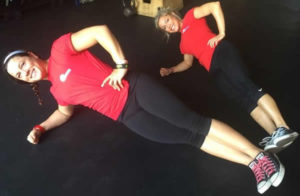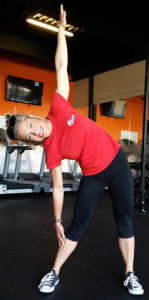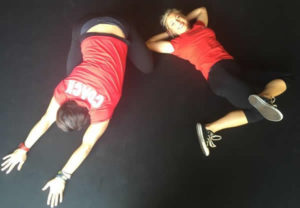The lowdown on the QL
By Nancy B. Loughlin
Published in News Press on May 26, 2015

Magen Wooley and Leslie Maxwell, certified personal trainers with Around the Clock Fitness, strengthen the quadratus lumborum.
Perhaps you sit on the wallet tucked in your back pocket.
Is your favorite pose standing sassy, popping out your hip?
Day after day, do you tote that heavy briefcase or purse in the same hand, or, worse, the dreaded backpack hangs off one shoulder?
These common habits can wreak havoc on your quadratus lumborum, the deep muscle that connects your hip and lower spine to the rib cage. It’s the hip-hiker.
A strained quadratus lumborum, otherwise known as the QL, is a frequent culprit for lower back pain, the deep ache that hovers on either side of your spine.
In the words of Chad Waterbury, physiologist and fitness author based in California, the QL is the “key player” for stabilizing the spine and pelvis.
“It’s weakness in this muscle that will rob you of power,” he said.
If your QL isn’t strong, the body will spread the strain of bending and carrying to the shoulders, back, hips and even the knees.
Not only should this muscle be strong, it should be balanced, Waterbury explained in a telephone interview. So, if you commit any of the aforementioned postural sins, your QL will become asymmetrical, one side overstretched and the other locked short.
Is your QL out of whack?
The Asymmetry Test
The one test Waterbury suggests is holding side plank. Prop yourself up on your forearm while lying on your side. Stretch your legs long, and stack them one on top of the other. Inhale and lift your hips toward the ceiling, pushing your forearm into the floor, the other hand on your hip. Try to hold for forty seconds before switching sides.
You know you have a QL strength imbalance if you can hold one side for 8 to ten seconds longer than the other, he said.
Strengthening the QL
Side planks will strengthen the QL (along with other muscles), so focus on your weaker side first. Waterbury suggests that you hold one plank for forty seconds to a minute on your stronger side, but do three planks on the other.
“Build balance before strength,” he said.
Next, give your QL targeted practice in doing its job. Hold a weight in one hand and walk. Task your awareness and effort to keeping your hips level. Walk for three minutes, and then switch hands.
Close your QL strength workout with modified Triangle Pose. Take a wide stance with your feet parallel. Open your arms to your sides. On the exhale, take a deep side bend, and imagine that your body is between two sheets of glass. Your arms are in a straight line. Your lower fingertips point to the ground while your top hand reaches to the sky. Hold for a minute before switching sides.
Now stretch it out.
The QL Stretches
Modified Child’s Pose. From your hands and knees, sit back on your heels and stretch your arms forward, lowering your face and front body toward the floor. Move into a lateral stretch of your right QL by walking your hands to the left. Hold for one minute before stretching your left side.
V Toe Touch. Sit with your legs in a wide V. Reach for the outside of your left foot with your right hand. Hold for one minute before switching sides.
Reclined hip twist. Lie on your back with your legs bent, soles on the floor. Cross one leg over the other, twist and then drop those knees to the floor. Hold and then switch.
For more intense relief of an aching QL, use myofascial release. While lying on your back with your legs bent, slide a myofascial release ball (or a tennis ball) under you aligned with your QL. It’s just below your rib, above your hip and about two inches away from your spine. As you lie on the ball, shift your body weight side to side to massage the muscle. Try to work the ball for about three minutes before working the other side.
Finally, always practice postural integrity. Balance your weight evenly on two parallel feet. Your thighs inwardly rotate. Your heart is above your pelvis, and your head floats above your heart.
For more information, visit Chad Waterbury’s website: www.chadwaterbury.com.



